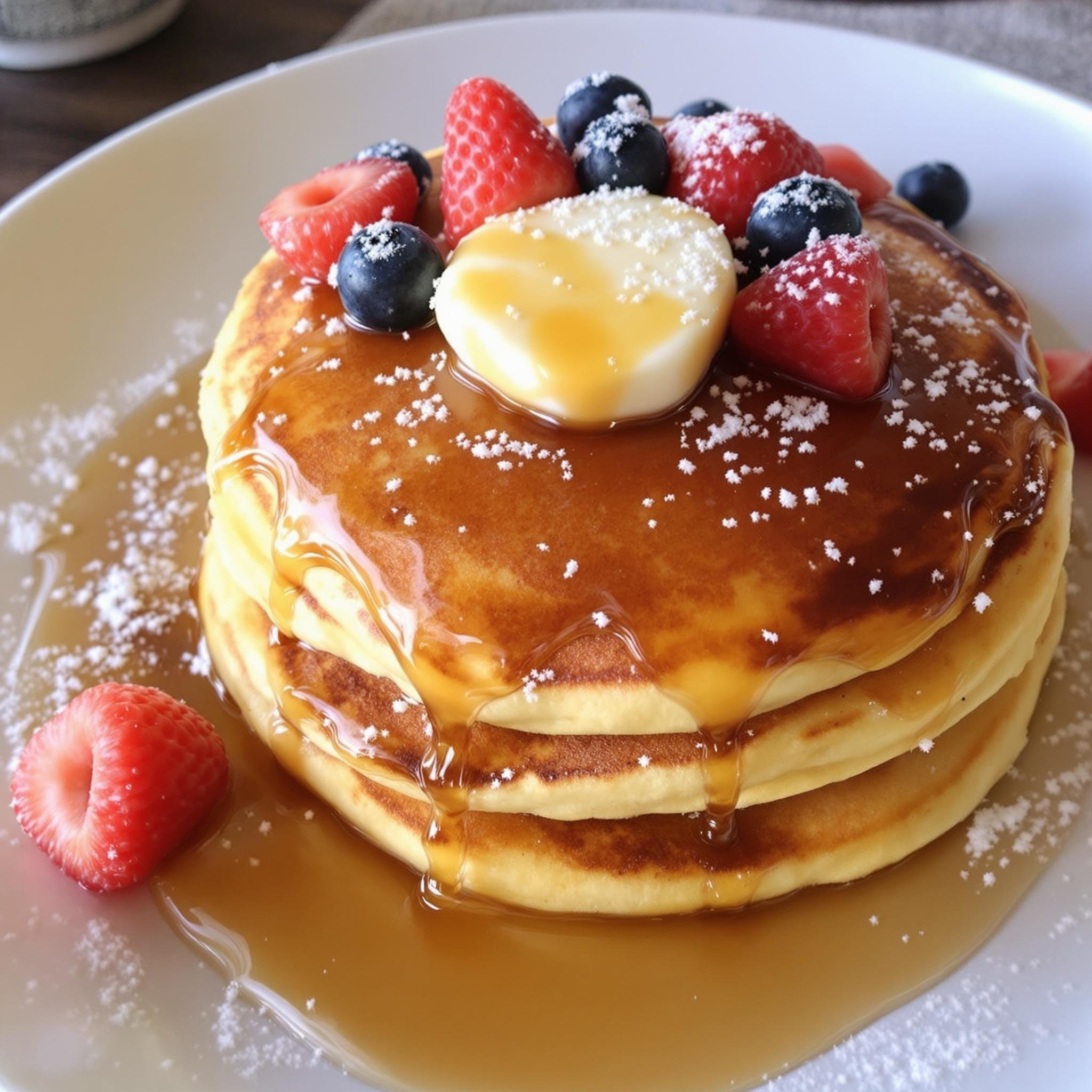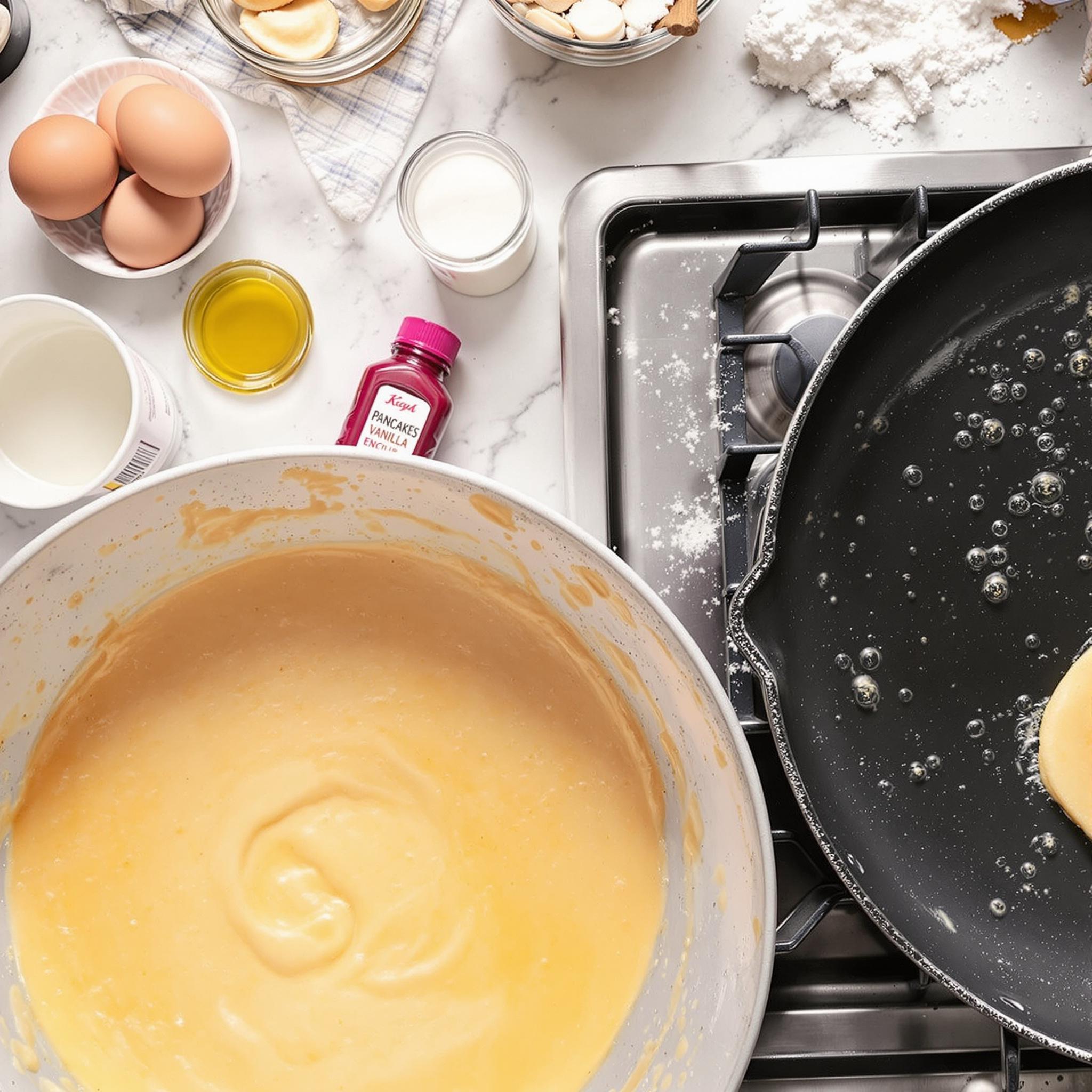
Introduction to Good Old Fashioned Pancakes
There’s something magical about flipping pancakes on a lazy Sunday morning. The aroma of butter and vanilla wafting through the air, the golden-brown edges forming perfectly in the pan—it’s comfort food at its finest. These Good Old Fashioned Pancakes have been a staple in my kitchen for years. They’re simple, nostalgic, and utterly delicious. Whether you’re feeding a crowd or just craving a cozy breakfast, this recipe is sure to become a family favorite.
The History Behind Classic Pancakes
Pancakes are one of the oldest breakfast traditions, dating back to ancient Greece when they were made with wheat flour, olive oil, honey, and curdled milk. Fast forward to today, and pancakes have evolved into countless variations worldwide. But there’s something timeless about the classic American pancake—fluffy, sweet, and served with a drizzle of maple syrup. I remember my grandmother making these Good Old Fashioned Pancakes for me as a child. She always said the secret was in the buttermilk, and now I carry on her tradition every time I whip up a batch.
Why You’ll Love These Fluffy Pancakes
What makes these pancakes stand out? First, their texture: light, airy, and melt-in-your-mouth soft. Second, their flavor: subtly sweet with a hint of vanilla that pairs beautifully with toppings like fresh berries or whipped cream. And finally, their simplicity. With just a handful of pantry staples, you can create restaurant-quality pancakes right in your own kitchen. Plus, they’re versatile enough to suit any dietary preference, whether you stick to the original recipe or opt for healthier alternatives.
Perfect Occasions to Make Classic Pancakes
These pancakes are perfect for weekend brunches, holiday mornings, or even a comforting weekday treat. I love serving them during family gatherings because they bring everyone together around the table. They’re also great for special occasions like birthdays or Mother’s Day—because who doesn’t love waking up to the smell of freshly cooked pancakes?
Ingredients for Good Old Fashioned Pancakes
- 1 cup all-purpose flour
- 2 tablespoons granulated sugar
- 1 teaspoon baking powder
- 1/2 teaspoon baking soda
- 1/4 teaspoon salt
- 3/4 cup buttermilk
- 1 large egg
- 2 tablespoons melted butter (plus extra for greasing the pan)
- 1 teaspoon vanilla extract
Substitution Options for Classic Pancake Ingredients
If you don’t have buttermilk, mix regular milk with a tablespoon of lemon juice or vinegar and let it sit for 5 minutes. For a dairy-free version, use almond milk or coconut milk instead. You can swap white sugar for honey or maple syrup if you prefer natural sweeteners. And for those avoiding eggs, try using a flaxseed “egg” (1 tablespoon ground flaxseed mixed with 3 tablespoons water).
Preparation Steps for Perfect Pancakes
Step 1: Mix the Dry Ingredients
Start by whisking together the flour, sugar, baking powder, baking soda, and salt in a large mixing bowl. This ensures the leavening agents are evenly distributed throughout the batter, which is key to achieving those fluffy pancakes we all crave. Pro tip: Sift the dry ingredients to remove lumps and aerate the mixture for an even lighter texture.
Step 2: Combine the Wet Ingredients
In a separate bowl, whisk together the buttermilk, egg, melted butter, and vanilla extract until smooth. The buttermilk adds a slight tanginess that balances the sweetness of the batter, while the melted butter gives the pancakes their rich flavor. Be careful not to overmix; a few small lumps are okay and actually help keep the pancakes tender.
Step 3: Bring It All Together
Pour the wet ingredients into the bowl with the dry ingredients and gently stir until just combined. Overmixing will develop gluten, resulting in dense pancakes, so stop stirring as soon as the batter comes together. Let the batter rest for 5 minutes while you preheat your skillet or griddle over medium heat. This resting period allows the baking powder to activate fully, ensuring maximum fluffiness.
Step 4: Cook the Pancakes
Lightly grease your skillet with butter or nonstick spray. Pour about 1/4 cup of batter onto the hot surface for each pancake. When bubbles form on the surface and the edges look set (after about 2-3 minutes), flip the pancake carefully using a spatula. Cook for another 1-2 minutes until golden brown. Repeat with the remaining batter, adjusting the heat as needed to prevent burning.

Chef’s Tip for Extra Fluffy Pancakes
For ultra-fluffy pancakes, separate the egg yolk from the white. Beat the egg white until stiff peaks form, then fold it into the batter at the end. This technique incorporates more air into the mixture, giving your pancakes an incredibly light texture.
Time Required to Make These Pancakes
- Prep Time: 10 minutes
- Cooking Time: 15 minutes
- Total Time: 25 minutes
Nutritional Information per Serving
- Calories: 180
- Protein: 4g
- Fat: 7g
- Carbohydrates: 26g
- Sugar: 8g
- Fiber: 1g
Extra Information About Pancakes
Did you know that pancakes are often called “hotcakes” in some parts of the United States? Or that February 25th is National Pancake Day? No matter what you call them, these fluffy delights have earned their place as a beloved breakfast classic.
Necessary Tools for Making Pancakes
- Nonstick skillet or griddle
- Whisk
- Mixing bowls
- Measuring cups and spoons
- Spatula
Storage Instructions for Leftover Pancakes
If you happen to have leftovers (which rarely happens in my house!), store the pancakes in an airtight container in the refrigerator for up to 3 days. To reheat, simply pop them in the toaster or microwave for a quick breakfast solution.
For longer storage, freeze the pancakes in a single layer on a baking sheet before transferring them to a freezer-safe bag. They’ll stay fresh for up to 2 months. Reheat frozen pancakes directly in the toaster for best results.
Finally, if you want to keep pancakes warm while cooking a large batch, place them on a baking sheet in a low oven (around 200°F) until ready to serve.
Tips and Tricks for Better Pancakes
– Use a ladle or measuring cup to pour consistent amounts of batter for evenly sized pancakes.
– Don’t press down on the pancakes with the spatula while cooking—it squeezes out the air and makes them flat.
– Always preheat your skillet before adding batter to ensure even cooking.

Serving Suggestions for Classic Pancakes
Serve these pancakes with classic toppings like maple syrup, fresh fruit, and whipped cream. For a fun twist, try spreading Nutella or peanut butter between two pancakes for a decadent sandwich. You can also dust them with powdered sugar for a touch of elegance.
Healthier Alternatives for Pancake Lovers
Here are six ways to make this recipe healthier without sacrificing taste:
1. **Whole Wheat Flour**: Swap half the all-purpose flour for whole wheat flour for added fiber.
2. **Greek Yogurt**: Replace some of the buttermilk with plain Greek yogurt for extra protein.
3. **Banana Mash**: Add mashed banana to the batter for natural sweetness and moisture.
4. **Oatmeal Batter**: Blend rolled oats into a fine powder and use it in place of part of the flour.
5. **Coconut Oil**: Use melted coconut oil instead of butter for a dairy-free option.
6. **Egg Whites Only**: Use only egg whites to reduce cholesterol while maintaining structure.
Common Mistakes to Avoid When Making Pancakes
Mistake 1: Overmixing the Batter
Overmixing leads to tough, rubbery pancakes due to excess gluten development. Instead, mix until the ingredients are just combined, leaving some lumps for a lighter texture. Pro tip: Stir gently with a wooden spoon rather than a whisk.
Mistake 2: Skipping the Resting Time
Letting the batter rest allows the baking powder to activate fully, creating fluffier pancakes. Skipping this step can result in denser cakes. Set a timer for 5 minutes and enjoy the anticipation!
Mistake 3: Using High Heat
Cooking pancakes on high heat causes them to burn on the outside before they’re cooked through. Keep the heat at medium and adjust as needed for perfectly golden pancakes every time.
Frequently Asked Questions About Pancakes
Can I make these pancakes ahead of time?
Yes! Prepare the batter the night before and store it in the fridge. Just give it a quick stir before cooking.
How do I know when to flip the pancakes?
Flip the pancakes when bubbles appear on the surface and the edges look set, usually after 2-3 minutes.
What can I substitute for buttermilk?
Mix regular milk with a tablespoon of lemon juice or vinegar and let it sit for 5 minutes to mimic buttermilk.
Can I freeze leftover pancakes?
Absolutely! Freeze them individually on a baking sheet, then transfer to a freezer bag for up to 2 months.
Why are my pancakes flat?
Flat pancakes could be due to expired baking powder, overmixing, or skipping the resting time. Check your ingredients and follow the steps carefully.
How can I make vegan pancakes?
Use plant-based milk, replace the egg with a flaxseed “egg,” and substitute butter with coconut oil.
Do I need a special pan?
A nonstick skillet works best, but any heavy-bottomed pan will do as long as it’s properly greased.
Can I add chocolate chips?
Of course! Fold mini chocolate chips into the batter before cooking for a sweet surprise.
Why does my batter turn gray?
This is normal! The reaction between baking soda and buttermilk can cause discoloration, but it won’t affect the taste.
What’s the best way to serve pancakes?
Top them with maple syrup, fresh fruit, whipped cream, or Nutella for a delightful breakfast experience.
Conclusion
Good Old Fashioned Pancakes are more than just a breakfast dish—they’re a celebration of warmth, nostalgia, and togetherness. Whether you’re making them for yourself or sharing them with loved ones, these pancakes promise to bring joy to your table. So grab your skillet, gather your ingredients, and get ready to create memories one fluffy pancake at a time!

10 Irresistible Good Old Fashioned Pancakes Recipes!
Ingredients
Equipment
Method
- Mix together all-purpose flour, granulated sugar, baking powder, baking soda, and salt in a large mixing bowl. Sift if necessary to remove lumps.
- In another bowl, whisk buttermilk, egg, melted butter, and vanilla extract until well combined.
- Pour the wet ingredients into the dry ingredients and stir until just combined. Avoid overmixing.
- Let the batter rest for 5 minutes while preheating the skillet over medium heat.
- Grease the skillet with butter and pour in about 1/4 cup of batter for each pancake. Cook for 2-3 minutes on each side or until golden brown.
